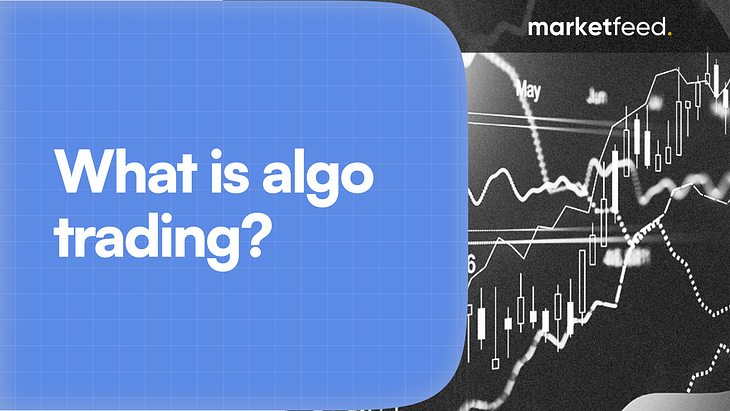What is Algo Trading? History, Benefits Explained!

Algorithmic trading or algo trading has become a popular buzzword in the financial markets over the past few years. It has revolutionised the way people trade. The combination of financial knowledge and computer programs has resulted in faster and more accurate trade executions. In this article, we will help you understand what algo trading is and how it works. We will also discuss the advantages and risks of algo trading in India.
What is Algo Trading?
Algo trading is a method of executing orders in the financial markets (stocks, currencies, commodities, derivatives, etc.) using automated or pre-programmed trading instructions. The 'algorithm' places orders based on specific rules and criteria. These criteria include price, timing, and quantity instructions. The trading algorithm follows the instructions to identify opportunities in the market and executes orders when the conditions are satisfied.
Algo trading removes human emotions from the equation. Therefore, it helps avoid manual decision-making and human errors.
What is an Algorithm?
An algorithm is a set of instructions/directions for solving a problem. It's a step-by-step process that helps us solve problems or make decisions. These programs or algorithms operate faster than humans and make decisions at lightning-fast speeds. It is a seamless integration of technology and finance.
Brief History of Algo Trading
Algo trading has a rich history, dating back several decades. It gained significant momentum with advancements in technology, which allowed for faster and more complex algorithms.
It all started in the 1970s when computerised trading systems emerged in the American financial markets. In 1976, the New York Stock Exchange (NYSE) introduced an electronic trading system, which traders loved and accepted quickly.
An author named Michael Lewis played a significant role in popularising algorithmic trading. He brought it to the attention of both market traders and the public through his writings, especially when he talked about high-frequency algorithmic trading (HFT). In the US stock market and many other developed financial markets, about 60-75% of the overall trading volume is now generated through algo trading.
In 2008, algo trading got the green light from SEBI (India's market regulator), and Direct Market Access (DMA) was introduced. DMA gives direct access to the electronic facilities and order books of the stock exchanges to execute trades. This opened the doors to high-frequency trading (HFT) in Indian stock exchanges, allowing more traders to participate actively in the market. But the real game-changer came in 2010 when large institutional brokers were permitted to co-locate their trading servers on the exchange premises. This tiny advantage of a millisecond gave them an edge over regular investors.
Click here to learn more about co-location.
How Does Algo Trading Work?
Algo trading is a complex process that involves many steps and processes. However, a basic outline of how algo trading works is given below:
1. Developing a Strategy
The first step in algo trading is to develop a trading strategy. Traders can create and develop strategies based on technical, fundamental, and quantitative analysis. Moreover, in recent times, traders have been using Artificial Intelligence (AI) and Machine Learning (ML) for sentimental and qualitative analysis. Historical patterns, indicator signals, price behaviour, etc., are also analysed to create strategies.
2. Writing the Algorithm
Once the strategy is developed, the next step is to convert it into a form that computers understand. Data scientists or traders write algorithms or codes that translate the strategy. Programming languages such as Python, C++, and Java are used to write algorithms for algo trading.
3. Backtesting
Before deploying an algorithm in live markets, traders backtest it on historical data. This means that the trading strategy gets simulated or replicated in the past market. Backtesting is necessary to understand its performance in the past. This step is based on the technical analysis principle that “history tends to repeat itself”.
However, past performance is never a guarantee of future performance. The backtesting provides different metrics such as the total return, average monthly return, standard deviation of returns, etc. [Here, deviation is nothing but a difference in the actual returns and the expected returns.] Traders make multiple optimisations and revisions before deploying the strategy in live markets.
4. Connectivity
An Application Programming Interface (API) establishes an online connection between a data provider and an end user. An API connects the algo trading system to a trading platform/broker. It is essential to implement an automated trading strategy. APIs enable real-time market data access and trade execution.
5. Order Execution & Risk Management
Once the algorithm is set, it’s time to wait. Algorithms continuously analyse market data according to the strategy. When the conditions in the strategy are satisfied, the system automatically executes buy or sell orders. Moreover, the algorithms also place stop-loss orders and perform position sizing based on the strategy to manage risk.
6. Monitoring and Forward Testing
Before the final deployment, the strategy needs to be forward-tested. Forward testing is a method of evaluating the performance of a trading strategy by applying it to real-time market data. Forward testing ensures that the algorithm works as intended. It helps to understand how our system performs in real-time, on data that the strategy has never seen before. Any deviations or unexpected variations are corrected and optimised further.
7. Final Deployment
After forward testing the strategy, the final step is to deploy the strategy. In forward testing, the account will not be fully funded. Here, the account is fully funded and deployed in real markets. Additionally, the trades and strategies get monitored and revised periodically.
Basic Types of Algo Trading
- High-Frequency Trading (HFT) - High-frequency trading (HFT) is a type of super-fast trading done by powerful computers. These computers use smart algorithms to quickly buy and sell stocks and other assets in different markets. Since they're so fast, HFT computers can make lots of trades in just a short time. Traders who use HFT aim to make profits by taking advantage of small price changes.
- Arbitrage Trading - Arbitrage refers to the practice of taking advantage of price differences for the same asset in different markets. This type of algo trading involves using automated computer programs to identify and exploit these price differences quickly and efficiently. To learn more about arbitrage trading, click here!
What are the Advantages of Algo Trading?
1. Speed and Efficiency
Algo trading operates at lightning-fast speeds. The computer program executes all the trades in mere seconds, enabling timely responses to market changes without delay. On the other hand, with manual trading, executing trades at such high speed and accuracy is impossible.
2. Accuracy
Algorithms can process large volumes of data and recognise patterns that human traders might often overlook. This results in more accurate trading decisions than human traders.
3. Eliminating Emotions or Bias
Algo trading eliminates emotional and psychological biases. Emotions such as fear, greed, and overconfidence can cloud judgment and lead to impulsive decisions. By relying on algorithms, traders can stick to predefined strategies without being influenced by market sentiments.
4. Backtesting and Optimization
Algo trading allows traders to backtest their strategies using historical data. Backtesting enables them to refine and optimise their algorithms for better performance. Traders can analyse an algorithm's past performance and make necessary adjustments to enhance its effectiveness in current market conditions.
5. Diversification
Algo trading enables traders to diversify their portfolios across multiple assets and markets, reducing overall risk exposure. Automated systems can manage multiple trades simultaneously. This allows traders to spread their investments across different strategies, asset classes, and sectors/industries.
What are the Risks of Algo Trading?
Although algo trading has many advantages, it is necessary to be aware of its risks.
1. Technical Failures
Algo trading relies heavily on technology, making it vulnerable to technical glitches, connectivity issues, or system failures. Technical failures can lead to significant and irrecoverable financial losses. Even a minor technical error can disrupt trade execution, leading to missed opportunities or losses. Poor internet connections or latency delays can impact trade execution and pricing.
2. Market Volatility
Rapid and automated trades executed by algorithms may lead to market volatility. Huge volatility can lead to quick crashes and unexpected market movements. In extreme market conditions, algorithms may develop market fluctuations due to their swift response to price changes, leading to market instability.
3. Over-Optimisation
Over-optimising algorithms based on historical data can lead to poor performance in real-market conditions. While algorithms may show good results in backtests, they may not adapt well to real-world market conditions. Therefore, over-optimising strategies may lead to underperformance.
4. Lack of Human Oversight
Relying fully on algo trading without human supervision may lead to unforeseen and unexpected outcomes. Moreover, algorithms may not account for market events or black swan events outside the scope of historical data.
5. Lack of Human Judgment
Algorithmic trading relies on mathematical models and historical data. So it does not consider the subjective and qualitative factors that can influence market movements. In this case, the lack of human judgment can be a disadvantage for traders who prefer discretionary trading.
In conclusion, algo trading has revolutionised the financial markets, introducing speed, accuracy, and efficiency in trade execution. By removing human emotions and leveraging the power of computer algorithms, traders can capitalise on market opportunities with remarkable precision. However, algo trading does come with inherent risks, making it essential for traders to exercise caution. As the landscape of financial markets continues to evolve, algo trading will undoubtedly play an increasingly vital role in shaping investment strategies and market dynamics.
Common FAQs on Algo Trading:
1. What is algo trading?
Algo Trading is a method of executing orders in the financial markets (stocks, currencies, commodities, derivatives, etc.) using automated or pre-programmed trading instructions.2. When was algo trading introduced?
Algo trading was first introduced in the United States during the early 1970s with the arrival of electronic trading systems.3. What are the major benefits of algo trading?
Algo trading has transformed the financial markets by introducing speed, accuracy, and efficiency in trade execution. By eliminating human emotions and harnessing the power of computer algorithms, traders can seize market opportunities with remarkable precision.4. Can algo trading be profitable?
Yes, algo trading can be profitable - provided that you have the right skills, mindset, and resources. It needs to be executed with proper risk management and backtesting. Ensure you follow the guidelines set by regulatory authorities (SEBI).


Post your comment
No comments to display